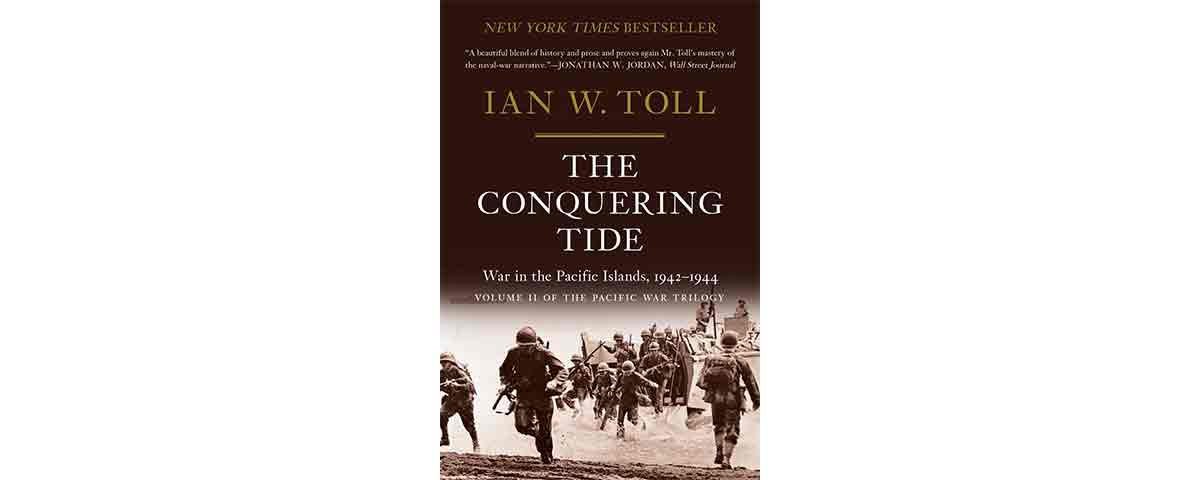The Conquering Tide: War in the Pacific Islands, 1942–1944
By Ian W. Toll. 656 pages.
W. W. Norton, 2015. $35.
Reviewed by David L. Sears
No one needs to persuade me of the relevance of a new panoramic history of World War II. As Hanson W. Baldwin, the former New York Times war correspondent and editor, once put it: “World War II is one with man’s Homeric yesterdays—an epoch, like the Trojan wars, to be read about, studied, imagined.” Now that Rick Atkinson has concluded his finely wrought Liberation Trilogy, we can pivot to Ian W. Toll’s The Conquering Tide, volume 2 of his Pacific War Trilogy. Those Pacific campaigns became personal odysseys for millions of soldiers, sailors, and airmen, and a comprehensive updating of the war in the Pacific, even without significant new scholarship, can add vital new perspective and context. And when Toll executes the narrative, we can be pretty certain it will deliver the goods.
All Pacific War historians write in the shadow of Samuel Eliot Morison, our prose Homer, whose History of United States Naval Operations in World War II still resonates. Morison had the “courage to simplify,” Yale historian Edmund S. Morgan once wrote. “To simplify where you know a great deal requires…unusual penetration of mind and, above all, sheer nerve.”
Morison’s history, encompassing the Atlantic and Pacific fronts, stretched to 15 volumes; Toll’s has just three. Moreover, while Toll’s first volume, Pacific Crucible, kaleidoscopes six months from Pearl Harbor to Midway, The Conquering Tide encompasses two years, replete not only with air and sea battles but with epic ground assaults in the southwest and central Pacific.
Embarking on such a far-reaching work truly requires the courage to simplify or, as Toll puts it, “to pay a lot of attention to some things and little or none to others.” That approach is obvious in his in-depth treatment of Guadalcanal and the Marianas and correspondingly lighter emphasis on what followed in the southwest Pacific, the Marshalls and Gilberts.
Toll shapes his narrative with deft visuals and tense action and fashions a fitting climax with the Battle of the Philippine Sea. While he cannot report firsthand as did Morison, it’s evident that Toll has trod such historic settings as Guadalcanal. The vignettes and quotes, drawn from archives and published secondary sources, are pitch perfect, marred only by a few fact-checking lapses: Alex Vraciu, a navy aviator quoted in several passages, was not, as Toll asserts, a Guadalcanal veteran; neither was William Manchester. Toll quotes Goodbye, Darkness, Manchester’s fine memoir, but leaves the mistaken impression that the young marine turned biographer fought not only on Guadalcanal but on Saipan, too. Manchester didn’t reach Guadalcanal until 1944.
Perhaps Toll exhibits his deepest penetration of mind in his cogent assessment of the Pacific War once the Marianas fell. “Though Americans were slow to appreciate it, they had just won the decisive victory of the Pacific War.” All across the Pacific their planes, ships, and troops surprised the Japanese. As Japanese admiral Kichisaburo Nomura lamented to postwar interrogators, “You came far more quickly than we expected.”
David L. Sears is a former U.S. Navy officer with extensive sea duty aboard a destroyer. His more recent books, on naval aviation, are Such Men as These (2011) and Pacific Air (2012).
This article originally appeared in the Spring 2016 issue (Vol. 29, No. 1) of MHQ: The Quarterly Journal of Military History with the headline: Reviews: The Conquering Tide War in the Pacific Islands, 1942–1944.
Want to have the lavishly illustrated, premium-quality print edition of MHQ delivered directly to you four times a year? Subscribe now at special savings!





